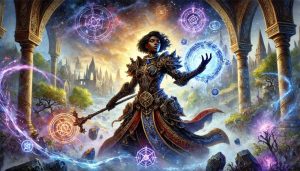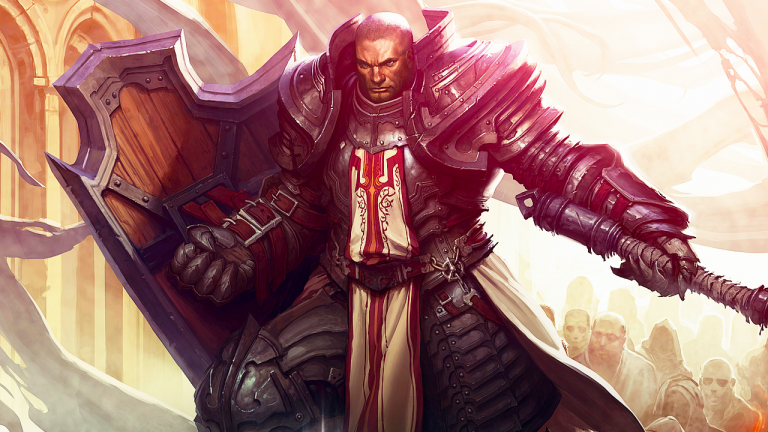In the realm of Dungeons & Dragons, few elements evoke as much intrigue and trepidation as curses. These mystical afflictions have long been a staple of fantasy storytelling, offering dungeon masters a potent tool for weaving complex narratives and challenging their players in unexpected ways. Among the vast array of dnd curse ideas, those with hidden consequences stand out as particularly captivating, promising a slow burn of revelation that can transform a campaign’s dynamics over time.
Curses with delayed effects are the silent assassins of the D&D world. They lurk beneath the surface, often masquerading as boons or trivial oddities, only to reveal their true, insidious nature as the story unfolds. This approach to curse design not only adds layers of mystery to your game but also creates opportunities for deep character development and long-term storytelling that can keep your players engaged session after session.
The allure of these hidden curses lies in their ability to subvert expectations. Players might initially celebrate what they perceive as a stroke of good fortune, only to gradually realize the price they must pay for their apparent luck. This slow revelation can lead to moments of dramatic irony, where the players’ growing awareness of their predicament adds tension and depth to every interaction and decision.
The Nature of Curses in D&D: Weaving Arcane Misfortune
In the rich tapestry of Dungeons & Dragons lore, curses occupy a unique space at the intersection of magic, morality, and fate. These supernatural afflictions are more than mere spells; they are manifestations of powerful negative energy, often born from intense emotions like vengeance, jealousy, or despair. Curses can be the result of a spiteful wizard’s incantation, the consequence of disturbing an ancient tomb, or even the price of a seemingly innocent mistake.
The D&D universe recognizes various types of curses, each with its own flavor and impact on gameplay. Some curses strike immediately, imposing obvious penalties or transformations that players must grapple with from the moment of affliction. These might include reduced ability scores, visible deformities, or compulsive behaviors that hinder the character’s actions. While these immediate curses can certainly add excitement and challenge to a game, they often lack the subtle, narrative-driving power of their more insidious counterparts.
Enter the realm of long-term, hidden curses – the focus of our exploration. These curses are the sleeper agents of the magical world, embedding themselves deep within a character’s essence and lying dormant until the right moment to strike. They might manifest as small, seemingly inconsequential changes at first, barely noticeable to the afflicted or their companions. Over time, however, these curses grow in power and influence, slowly reshaping the character’s reality in ways that can fundamentally alter their role in the story.
The true power of curses in D&D lies not just in their mechanical effects, but in their ability to drive character development and narrative tension. A well-crafted curse can become a central pillar of a character’s arc, influencing their decisions, relationships, and ultimate fate. It can serve as a constant source of conflict, both internal and external, pushing the character to explore new facets of their personality and challenging their established beliefs and motivations.
Moreover, curses can act as powerful plot devices, linking characters to larger mythological or historical contexts within the game world. They can serve as the impetus for epic quests, the source of recurring antagonists, or the key to unlocking ancient mysteries. In this way, curses become more than mere afflictions; they transform into narrative threads that can be woven throughout the entire fabric of a campaign, creating a rich and interconnected story that evolves with each session.
Immediate vs. Hidden Curses: The Spectrum of Arcane Afflictions
When it comes to dnd curse ideas, the spectrum ranges from the overt and immediate to the subtle and long-term. Understanding the characteristics and impacts of these different types of curses is crucial for Dungeon Masters looking to enrich their storytelling and challenge their players in novel ways.
Immediate curses are the flashy, in-your-face afflictions that make their presence known from the moment they take hold. These curses often manifest in ways that are impossible to ignore, both for the afflicted character and those around them. A character might suddenly find their strength sapped, leaving them struggling to lift their once-manageable weapon. Another might sprout horns or scales, marking them visibly as cursed and potentially altering how NPCs interact with them. These curses create instant drama and force players to adapt quickly to new circumstances.
The appeal of immediate curses lies in their ability to shake up the status quo rapidly. They can turn a routine encounter into a memorable challenge or instantly alter the dynamics of social interactions. However, their very obviousness can sometimes limit their long-term storytelling potential. Once revealed, immediate curses often become problems to be solved rather than evolving elements of the narrative.
In contrast, hidden curses operate in the shadows of the game world, their true nature concealed beneath layers of mystery and misdirection. These curses might initially appear as minor quirks or even beneficial traits, only to reveal their malevolent nature over time. For example, a character might find themselves unusually lucky in combat, always managing to land critical hits at crucial moments. Only later do they realize that this “luck” comes at the cost of draining the life force of their allies.
The allure and danger of hidden curses lie in their unpredictability and potential for dramatic revelation. Players may spend sessions or even entire story arcs unaware of the true nature of their affliction, making choices and forming relationships based on incomplete information. When the curse’s true nature is finally revealed, it can lead to moments of profound realization that reshape the entire narrative landscape.
Hidden curses also offer rich opportunities for role-playing and character development. As the effects of the curse gradually become apparent, players are challenged to interpret and react to these changes in-character. This can lead to deep, nuanced explorations of identity, morality, and the lengths to which a character might go to understand or break free from their affliction.
Furthermore, hidden curses can serve as excellent tools for DMs to create long-term story arcs and recurring themes. The gradual unfolding of the curse’s effects can be tied to key plot points, with each new manifestation driving the story forward in unexpected ways. This approach keeps players engaged and invested in uncovering the mysteries surrounding their characters, adding layers of intrigue to the overall campaign.
Crafting Curses with Hidden Consequences: The Art of Subtle Doom
For Dungeon Masters seeking to elevate their storytelling, crafting curses with delayed effects is a powerful tool in their narrative arsenal. These insidious afflictions require a delicate balance of subtlety and foreshadowing, allowing them to simmer beneath the surface of the campaign before coming to a dramatic boil. When designing such curses, DMs should consider not just the immediate impact, but the long-term ramifications that will unfold over multiple sessions or even entire story arcs.
The key to an effective hidden curse lies in its initial presentation. Consider introducing the curse as something seemingly benign or even beneficial. Perhaps a character gains the ability to see in the dark after disturbing an ancient tomb, only to find that their vision gradually becomes more sensitive until even candlelight causes them pain. This approach not only subverts player expectations but also creates a sense of unease as they wait for the other shoe to drop.
When developing dnd curse ideas with hidden consequences, it’s crucial to plan out the curse’s evolution. Create a timeline of how the curse will manifest, with each stage introducing new complications or revelations. This gradual unveiling allows players to piece together the puzzle of their affliction over time, encouraging engagement and speculation. For example, a curse that slowly turns a character to stone might begin with occasional muscle stiffness, progress to visible patches of stony skin, and ultimately threaten complete petrification.
Incorporating the curse into the broader narrative can significantly enhance its impact. Link the curse’s progression to key plot points or character decisions, making it an integral part of the story rather than just a mechanical hindrance. This approach not only adds depth to the curse itself but also creates opportunities for character growth and plot development. A curse tied to an ancient prophecy or a forgotten deity can drive the entire party on a quest for answers and resolution.
The Art of Delayed Consequences: Crafting a Slow-Burn Revelation
Mastering the art of delayed consequences is essential for DMs looking to create truly memorable hidden curses. The goal is to craft an affliction that unfolds gradually, keeping players on their toes and constantly reassessing their understanding of the curse’s nature. This approach requires careful pacing and a keen sense of dramatic timing.
Begin by introducing the curse in a way that seems innocuous or even desirable. A character might find that they no longer need to sleep, initially viewing this as a boon that allows them to take extra watches or study spells through the night. However, as time passes, the lack of sleep begins to take its toll on their psyche, leading to hallucinations or difficulty distinguishing reality from dreams. This gradual shift from benefit to detriment creates a compelling narrative arc and challenges players to adapt to changing circumstances.
As you reveal the true nature of the curse, use a combination of subtle hints and more overt manifestations. Describe small, easily overlooked changes in the character’s behavior or appearance. Perhaps their reflection in mirrors begins to distort slightly, or they find themselves drawn to shadows without realizing why. These minor details can be sprinkled throughout sessions, building tension and encouraging players to pay close attention to their surroundings and actions.
Timing is crucial when it comes to revealing the more significant aspects of the curse. Plan these revelations to coincide with dramatic moments in the campaign, using them to heighten tension or complicate already challenging situations. A curse that causes a character to involuntarily shapeshift might first manifest during a tense negotiation with a hostile faction, adding an extra layer of complexity to an already precarious situation.
Remember that the pacing of the curse’s evolution should match the overall tone and tempo of your campaign. In a fast-paced, action-driven game, the curse might progress more quickly, with new manifestations appearing every few sessions. In a slower, more intrigue-focused campaign, you might stretch the curse’s development over a longer period, allowing for deeper exploration of its effects on the character and their relationships.
Psychological and Social Impacts: The Unseen Scars of Arcane Affliction
The true power of hidden curses lies not just in their physical manifestations, but in their profound psychological and social impacts on the afflicted characters. These curses can become catalysts for deep character development, pushing players to explore new facets of their alter egos and grapple with complex emotional challenges.
As the curse slowly reveals itself, the afflicted character may experience a range of psychological effects. Paranoia might set in as they begin to notice strange occurrences, unsure if they’re truly cursed or simply imagining things. This uncertainty can lead to self-doubt, anxiety, and even depression as the character struggles to understand and control their changing reality. DMs should encourage players to roleplay these internal struggles, perhaps through private conversations or journal entries that give insight into the character’s state of mind.
The social ramifications of a hidden curse can be equally compelling. As the curse progresses, it may strain relationships within the party and with NPCs. A character who finds themselves inadvertently draining the life force of those around them might become increasingly isolated, torn between their need for companionship and the fear of harming others. This isolation can lead to misunderstandings and conflicts, as other characters struggle to understand the sudden changes in their companion’s behavior.
Trust becomes a central theme when dealing with hidden curses. The afflicted character may be hesitant to reveal their condition to others, fearing rejection or exploitation. This secrecy can create tension within the party, especially if the curse begins to impact group dynamics or mission success. When the truth finally comes to light, it can lead to powerful moments of vulnerability and solidarity as the party decides how to support their cursed companion.
Long-term social consequences of hidden curses can reshape a character’s place in the world. A once-respected leader might find their influence waning as the curse causes erratic behavior or visible changes. Alternatively, a character might gain a fearsome reputation due to the curse’s effects, altering how NPCs interact with them and potentially opening up new storylines or quest opportunities.
By exploring these psychological and social dimensions, DMs can transform hidden curses from mere plot devices into rich, character-driven narratives. The struggle against the curse becomes not just a physical or magical challenge, but an emotional journey that can redefine a character’s identity and purpose within the campaign world.
Examples of Hidden Curses for Your Campaign: Seeds of Arcane Mischief
To spark your imagination and provide practical tools for your next campaign, here’s a collection of unique dnd curse ideas that embody the concept of hidden consequences. Each of these curses is designed to start subtly, gradually revealing its true nature over time, and can be adapted to fit various campaign settings and character backgrounds.
The Curse of the Golden Tongue
Initial Appearance: The afflicted character gains a supernatural gift for persuasion, finding it easier to sway others to their point of view. Their words seem to carry a magical weight, making even the most stubborn listeners consider their arguments.
Long-term Effect: As the curse progresses, the character’s persuasive abilities continue to grow, but at a terrible cost. They gradually lose the ability to speak truthfully, their words always twisting into lies or half-truths, regardless of their intentions. Eventually, the character may find themselves unable to communicate at all, trapped in a prison of silence by their own golden tongue.
Narrative Potential: This curse can create fascinating roleplaying challenges, forcing the player to navigate complex social situations while grappling with their diminishing ability to be honest. It can lead to misunderstandings within the party, complicate negotiations with NPCs, and potentially drive the character on a quest to rediscover the value of truth.
The Curse of Eternal Youth
Initial Appearance: The cursed individual finds that they no longer age, their appearance frozen at the moment the curse took effect. They may even experience a renewal of vigor and vitality, feeling stronger and more alive than ever before.
Long-term Effect: While the character’s physical form remains unchanging, their mind begins to falter. New memories become fleeting, slipping away like sand through an hourglass. Over time, the character struggles to form lasting connections or learn new skills, trapped in an eternal present with an ever-fading past.
Narrative Potential: This curse explores themes of identity and the nature of existence. The afflicted character must grapple with watching loved ones age and die while they remain unchanged. The loss of memory can lead to poignant moments as they struggle to hold onto important relationships and experiences. It can also drive a quest for a cure, racing against the gradual erosion of self.
The Curse of the Mirrored Soul
Initial Appearance: When looking into reflective surfaces, the cursed character always sees themselves in their best light – more attractive, more confident, an idealized version of themselves. This can boost their self-esteem and even provide a minor bonus to Charisma-based checks when they’ve recently seen their reflection.
Long-term Effect: Over time, the reflection begins to develop a will of its own. It starts by making subtle changes to its appearance, then progresses to mimicking actions the character hasn’t taken. Eventually, the reflection can influence the character’s actions, sometimes even taking control briefly when the character is near a reflective surface.
Narrative Potential: This curse plays with themes of identity and self-image. It can create suspenseful moments when the character isn’t sure if they’re in control of their own actions. The growing independence of the reflection could lead to it becoming a sort of alternate personality or even a full-fledged antagonist, turning every mirror into a potential threat.
Implementing Hidden Curses in Your Campaign: Weaving Threads of Doom
Integrating these hidden curses into your ongoing D&D campaign requires finesse and careful planning. The key is to introduce the curse in a way that feels natural and connected to the existing narrative, rather than a random affliction tacked on for the sake of complexity.
Consider the current goals and challenges your party faces. Perhaps the curse is tied to an artifact they’ve been seeking, or it’s the unintended consequence of a powerful spell cast to overcome a major obstacle. By linking the curse to the party’s actions or the main plot, you create a sense of consequence and interconnectedness that enriches the overall story.
When introducing the curse, start with subtle hints that can be easily overlooked in the heat of the moment. A character touching an ancient relic might feel a momentary chill, or a strange symbol might briefly appear on their skin before fading away. These initial signs should be ambiguous enough that players might not immediately realize they’ve been cursed, but memorable enough to create a sense of unease.
As the curse begins to manifest, be prepared for a range of player reactions. Some may embrace the mysterious changes, weaving them into their character’s development. Others might become frustrated or anxious about the loss of control. It’s crucial to maintain open communication with your players, ensuring that the curse enhances rather than detracts from their enjoyment of the game.
To keep players engaged with the evolving curse, sprinkle clues and potential leads throughout your campaign. Ancient tomes in a wizard’s library might hint at similar curses from history. A seasoned NPC might recognize the signs and offer cryptic warnings. These breadcrumbs not only help players piece together the nature of their affliction but also provide hooks for side quests and character development.
Remember that the reveal of a hidden curse should be a dramatic moment. Time it for maximum impact, perhaps during a crucial battle or a pivotal social encounter. The realization that a character’s strange new abilities or quirks are actually symptoms of a insidious curse can be a game-changing twist that propels the story in exciting new directions.
Player Agency and Curse Management: Balancing Challenge and Fun
While hidden curses can add depth and excitement to your campaign, it’s crucial to maintain a balance that preserves player agency and enjoyment. The goal is to create challenges that engage players rather than frustrate them, and to ensure that the curse enhances rather than overshadows character development.
Encourage players to find creative ways to cope with or mitigate the effects of their curses. This might involve researching magical remedies, seeking out powerful clerics, or even learning to harness the curse’s effects for their benefit. By giving players avenues to actively engage with the curse, you transform it from a passive affliction into a dynamic part of their character’s journey.
Consider allowing moments of respite or temporary control over the curse’s effects. Perhaps a magical amulet can suppress the curse for short periods, or certain environments weaken its hold. These moments of relief not only provide tactical options for players but also heighten the drama when the curse reasserts itself.
The possibility of redemption or breaking the curse entirely should always be on the table, though the path to such resolution should be appropriately challenging. Tie the quest to break the curse into the larger narrative of your campaign. Perhaps the key to lifting the curse lies in the very artifact or location the party has been seeking all along, adding extra weight to their primary mission.
As the DM, be prepared to adapt and adjust the curse’s effects based on player reactions and the needs of your story. If a particular aspect of the curse is proving more frustrating than engaging, don’t be afraid to modify it. Conversely, if players are particularly intrigued by certain manifestations of the curse, consider expanding on those elements.
Finally, use the curse as a tool for character growth and party bonding. The shared challenge of dealing with a cursed companion can strengthen relationships within the group. It can also provide opportunities for other characters to shine as they step up to support their afflicted friend, showcasing the power of teamwork and compassion in the face of adversity.
Conclusion: Embracing the Power of Hidden Curses
As we’ve explored throughout this guide, hidden curses with long-term consequences offer a powerful tool for Dungeon Masters looking to enrich their storytelling and create memorable campaigns. These insidious afflictions go beyond simple mechanical penalties, weaving complex narratives that challenge players to think creatively, roleplay deeply, and engage with the game world in new and exciting ways.
By implementing hidden curses, you invite your players into a world of mystery and gradual revelation. The slow burn of a well-crafted curse can keep players on the edge of their seats, constantly questioning their perceptions and adapting to new challenges. It transforms character development from a linear progression into a dynamic journey of discovery and adaptation.
Remember, the true power of these curses lies not in their ability to hinder players, but in their capacity to generate compelling stories. Each manifestation of the curse, each struggle to understand or control it, becomes a thread in the rich tapestry of your campaign. These personal battles can often become as engaging and memorable as any dragon slain or dungeon conquered.
As you experiment with these dnd curse ideas in your own games, don’t be afraid to push boundaries and subvert expectations. The most effective curses are those that surprise both you and your players, taking the story in directions none of you anticipated. Embrace the unexpected turns and let the narrative grow organically from the interplay between the curse’s design and your players’ reactions.
Ultimately, hidden curses serve as a reminder of the depth and complexity possible in tabletop roleplaying games. They challenge us to look beyond simple binaries of good and evil, to explore the nuanced consequences of our actions, and to find strength and growth in adversity. So go forth, brave Dungeon Masters, and weave these threads of arcane mischief into your campaigns. The tales of triumph, tragedy, and transformation that result will be the stuff of legend at your gaming table for years to come.
The post Unleash Silent Doom: Mind-Blowing DND Curses That Will Haunt Your Players for Years appeared first on LitRPG Reads.












